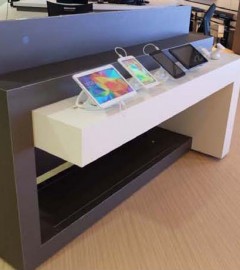
This is a column about how technology is changing the shopping experience. One example I’m personally familiar with is a large, regional furniture chain in the South that has gone wireless with its sales transactions. Now customers pay their salesperson, who is armed with a tablet computer, from anywhere in the store, perhaps even while seated comfortably on the sofa they are about to purchase.
With their new mobile devices, sales staff have access to product pricing, promotion details and inventory status at their finger tips, all of which help to streamline the selling process. Additionally, they were able to free up prime sales floor real estate by removing the old finance and payment centers, consisting of bulky counters, similar to those you find in a bank, and make room for an attractive, high yielding mattress gallery in one of the most prominent locations in each of the stores.
Self-Help. Plus Knowledgeable Experts
In other retail segments, similar technologies are transforming the shopping experience in new ways. Lowe’s, Mooresville, N.C., has deployed 42,000 iPhones that store associates will use to assist customers in its home improvement stores. The Atlanta-based Home Depot is also using hand-held tablet computers in its stores.
I’m convinced it won’t be long until a mattress retailer embraces a similar approach, using touch screen terminals to help customers seek out information and also providing the expertise of knowledgeable sales associates. Buying a mattress is such a personal process. It involves so much information that, having multiple touch-screen kiosks in a mattress department would help customers get answers to questions that might be hard to ask of a sales associate they just met like “What’s a good mattress for my back problem?”, “Are there mattress for allergy sufferers?”, or “Are there mattresses for overweight people?”
Large, TV-style displays on the wall are part of major consumer destinations, including Apple stores. The wall displays call attention to hot, new products and store promotions. The advantage of the electronic displays is they’re easy to update and a screen can scroll through several messages. A mistake that I see some retailers make is to change the message in the digital displays too quickly in a way that’s distracting. I advise clients to keep the displays relatively static, with the image changing after several minutes. Doing so helps promote a calm environment where customers don’t constantly feel their attention drawn away from their shopping mission.
In this Smartphone age, store windows using electronic displays can also draw the attention of potential customer after store hours. A mattress store, for example, could use a video display to tout health benefits or a new store promotion, and it could invite customers to get more details by scanning a QR code on the store’s window.
The possibilities are really endless, and the savviest merchants are taking new approaches to reach the well-to-do customer who are making Smartphones and tablets part of their daily lives, including the way they shop and seek out information on potential purchases.